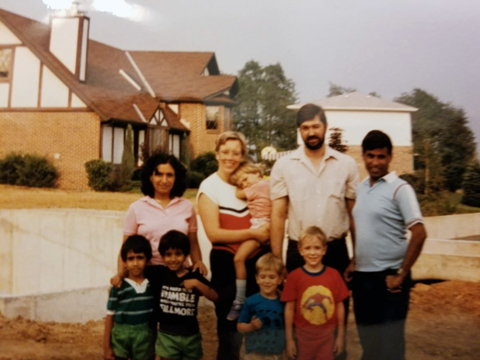An Indian-American Journey
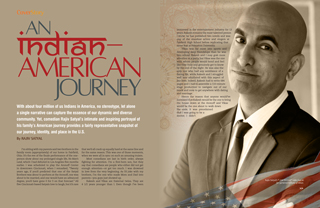
With about four million of us Indians in America, no stereotype, let alone a single narrative can capture the essence of our dynamic and diverse community. Yet, comedian Rajiv Satyal’s intimate and inspiring portrayal of his family’s American journey provides a fairly representative snapshot of our journey, identity, and place in the U.S.
I’m sitting with my parents and two brothers in the family room (appropriately) of our home in Fairfield, Ohio. It’s the eve of the finale performance of the one-person show about my prolonged single life, No Man’s Land, which I had debuted in Los Angeles five months earlier. I was scheduled to play the Aronoff Center in downtown Cincinnati, when I remarked, “Twenty years ago, if you’d predicted that one of the Satyal Brothers was about to perform at the Aronoff, one was about to be married, and one would have an advanced degree, you’d have gone 0 for 3 on that forecast.” All five Cincinnati-based Satyals love to laugh, but it’s rare that we’d all crack up equally hard at the same line and for the same reason. This was one of those moments, when we were all in sync on such an amusing truism.
Most comedians are last in birth order, always fighting for attention. I’m a first-born son, but they say that comedians are people who either did not get enough attention—or got too much. I was drowned in love from the very beginning. As I’d joke with my brothers, I’m the one who made Mom and Dad into parents—you guys just showed up.
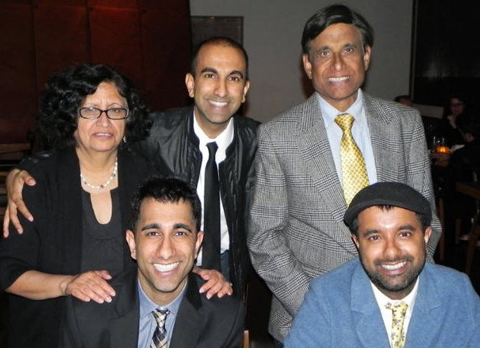
(Left) The Satyal family, from left: mother Lalita, brother Vikas, Rajiv, father Vinay, and brother Rakesh.
Rakesh and Vikas are fraternal twins. They are 4 1/2 years younger than I. Even though I’ve been immersed in the entertainment industry for 13 years, Rakesh remains the most talented person I know: he has published two novels and was one of the standout actors and singers at Fairfield High School before replicating that same feat at Princeton University.
Vikas was far more into sports and developing deep friendships than he was into school. Rakesh and I may grab more attention at a party, but Vikas was the one with whom people would bond and feel like they truly and genuinely got to know by the end of the night. He was also the only one who had any semblance of a dating life, while Rakesh and I struggled well into adulthood with this aspect of our lives. Indeed, Rakesh had to write 684 pages and I had to assemble a 110-minute stage production to navigate out of our muck and mire to get anywhere with dating and marriage.
Hence the reason that anyone would’ve surmised that Rakesh would be the one to bring the house down at the Aronoff and Vikas would be the one about to walk down the aisle. It was preordained that I was going to be a doctor; I didn’t realize this was an Indian parents’ dream as much as it is just something a nerdy math & science kid did.

(Left) Brother, Rakesh Satyal, with his spouse John Maas.
It turned out I had the brains but not the heart for a 9-to-5 job, let alone a 7 am-10 pm job. I left Corporate America at the age of 30 and went full-time into comedy. Rakesh graduated from Princeton with a degree in Comparative Literature, jaunted up to New York, and became a kick-ass book editor/publisher and author. (Not being a comp lit major, the best adjective I can employ is “kick-ass.” He might write “consummate” or “efficacious” or “prodigious.”) Rakesh took a break to relocate to San Francisco, found the love of his life, and married Stanford Grad and Fellow Kick-Ass Book Editor/Publisher John Maas in December 2016.
Vikas, an academic late bloomer, turned it on at Miami University in Oxford, Ohio, earning a double degree in Marketing and Management Information Systems, and then banged out an M.B.A. at Xavier University in Cincinnati. He’s climbed the ranks at Heineken in New York and has earned accolades all over the City—40 under 40 lists, the whole nine (or the whole forty). He’s not married but he literally has three degrees to the one each that Rakesh and I hold. (Although he doesn’t get the third degree that most spouses get on a routine basis.)
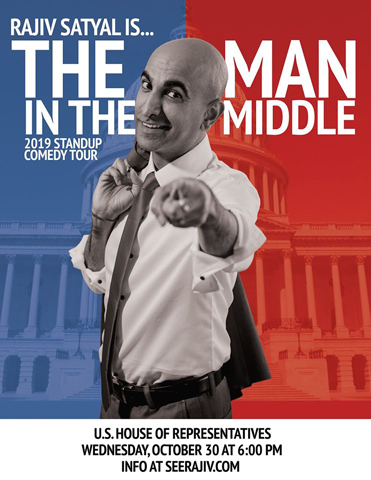
(Left) Rajiv’s quintessential Indian-American success story has seen him perform at the U.S. House of Representatives, interview the likes of Deepak Chopra and Hasan Minhaj, and, with his upcoming performance in Antarctica aboard a cruise ship, he may well become the first stand-up comedian to have performed in all seven continents.
I didn’t earn a Master’s or a Doctorate, leaving Xavier University myself after three courses, to move to Los Angeles to pursue my passion. My own personal tagline for a while was a twist on Biggie Smalls: “Considered a Fool ’Cause I Dropped Outta Grad School.” Heh. Good on me for going into comedy and not street poetry.
Why the westbound voyage? When I turned 30, I flipped out. Sure I had the house, the car, the job at P&G, and the Indian girlfriend. But if you’re the son of Indian immigrants in America, you’re pretty much an idiot if you can’t pull this off. These were not my accomplishments; they were my parents’. Vinay and Lalita Satyal, without stating these as policies, reared us with No Spanking, No Curfews, No Grounding, and No Allowances. They didn’t raise a hand on us; we could stay out as late as we wanted as long as we called home; we were hardly ever prevented from doing anything, despite being pretty darned mischievous; and we got money from our very-middle-class parents whenever we needed it. As long as we were doing well in school and were good to each other, to our parents, and to our friends, we could have all the Transformers, G.I. Joes, and Barbie Dolls we wanted. I’ll let you figure out who got what.
What makes the Satyals so different? My Dad’s sense of adventure and longing can be traced back to his birth in Naushehra. In 1947, the British, in a parting shot, decided Naushehra was no longer in India but a new place called Pakistan. My Dad’s upper-class family had to pick up whatever they could carry and cross the Line of Partition into India.
Vinay Satyal had a loving childhood but a tougher adolescence, moving to Bombay and striking out on his own, landing solid positions with the Income Tax Department and Hindustan Lever.
Lalita Satyal was born in Jalandhar, also located in Punjab. Her progressive father and mother, who had two sons and four daughters, promised them that they’d all get educated regardless of gender. My Mom and Dad met when they became neighbors in Allahabad, and to show how out-of-the-box they are, actually dated! In India. In the late 1960s. Rakesh and I couldn’t pull that off in America in the 1990s.
In another unusual move, my Mom actually came over to the States first, earning two Master’s Degrees and becoming an elementary school teacher and later a Hindi Professor. She traveled back to marry my father in 1972; in fact, last year, when I did 28 standup gigs in 28 days across India, my parents came with me—because I was 42 years old. We visited their homes and their rendezvous spot (El Chico) in Allahabad, and even saw the Bombay Temple where they had their “love marriage,” as it is known.
|
|
|
The Satyals in the mid-1980s with their good friends, the Krinovs. Unlike today, till the early to mid ’80s, assimilation into the mainstream was the norm, considering there were so few Indians around. “Till today they remain our dear friends. Nancy [Krinov] and I are very close and cherish our friendship as our kids also enjoy the friendships with each other,” says Mrs. Lalita Satyal. |
My parents are still some of the only immigrants I know who have almost as many white friends as brown ones. Mom and Dad blended very well into the Greater Cincinnati community, my Mom rockin’ bell bottoms as soon as she made it to Miami University (yes, the same place Vikas would attend two decades later). When people wonder why the sons of a Hindi Professor don’t speak better Hindi, I remind them that the mantra at the time was assimilation; my theory is that if you are born in the U.S. before 1984, you most likely do not speak Hindi (or your mother tongue). Kids born post-1984 speak not only Hindi but also Punjabi, Gujarati, Marathi—and that’s only the South Indians. Yes, in India, they keep their smart people in the South. Hey-Oh! But we digress…
My parents became U.S. citizens early on and spoke English at home. They only fought in Hindi. I knew a disagreement was about to break out when my Dad would look at my Mom and exclaim, “Hindi mein baat karo ab!”
The reality is that if you are born speaking one language and then go on to speak another, there are three holdovers: you’ll still fight in Hindi … you’ll do math in Hindi … and you’ll dream in Hindi.
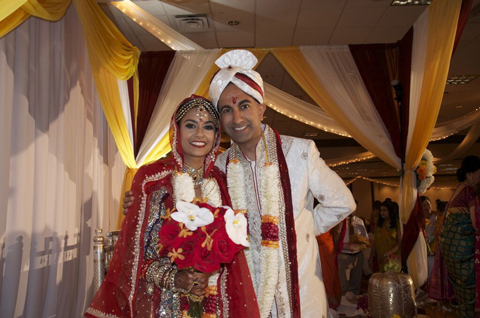
(Left) Rajiv Satyal, with his wife Harsha, at their wedding in 2015.
And some days, this journey has felt like a dream. After ~40 years in this country, though we’re scattered from New York to Cincinnati to Los Angeles, you can still find my retired parents doing their Bollywood Music & Masala program on public radio, Rakesh and John editing books, Vikas employing that marketing and sales knowledge to ship cases of beer, and my wife Harsha and me traveling the world for my standup gigs. (Harsha’s from the American South, so I might get the aforementioned third degree from her when she reads that joke.) Believe it or not, I met her online within hours of that Aronoff Center show about my single life. #Kismet (If you can’t earn your own advanced degree, marry into it. She’s a pharmacist and Laughter Is the Best Medicine, after all.)
Oh, and I think there’s still time for me to earn that M.D. My Mom’s Dad made it to 98 and my Dad’s grandparents all the way to 104. I need something to do in my nineties.
Rajiv Satyal is a standup comedian. He resides in Los Angeles.
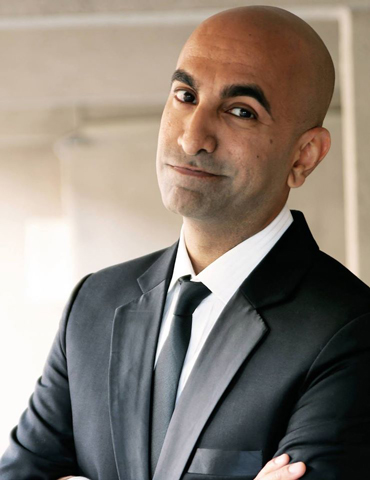
RAJIV SATYAL ON IDENTITY
(Right) Rajiv Satyal’s “I AM INDIAN” video has so far garnered millions of views.
Your video, “I AM INDIAN,” became a massive viral
hit. What inspired you to make that video?
The “I AM INDIAN” video came out of my soul.
It was one of those creative endeavors for which
I just dug very deep into myself. I had a crack team
assembled and my director pushed me and pushed
me to keep rewriting until it felt right.
Towards which side of your hyphenated identity
do you tilt? Do you consider yourself equally
comfortable in both, or equally outcast in both?
It would be a lot easier for my comedy career, both
creatively and successfully, if I felt an Indian outcast
in American society. That is the overwhelming point-of-view of my colleagues, be they standup comedians,
actors, writers, or directors. But my story is different.
My parents settled outside of Cincinnati, Ohio, where
there were very few Indians. In a way, I long for those
days, because they’d make friends with anyone brown.
As Punjabis, we got to know the families of Raji
Subramaniam [a South Indian] and Yasmin Khaja [a
Muslim]. That’s a rarity now. We’re all segmented into
our groups and organizations and samajs as Punjabis
and Gujaratis and Tamils and Bengalis.
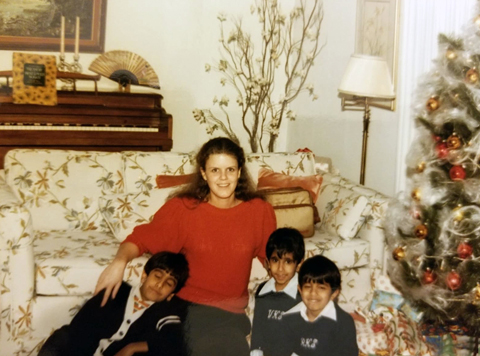
(Left) The young Satyal brothers in 1985 with their babysitter Lisa Abney.
I never felt alienated amongst white folks, perhaps because my parents had such communicative jobs; my Dad worked as a salesman for General Mills and my Mom as a school teacher. Since they had full-time jobs, we started going to daycare around the age of three so we were socialized very early into American life.
My theory on (I have a lot of theories) being comfortable in America really comes down to whether you attended high school in America. American high school life is quintessential. If you at least went through Junior and Senior years in an American high school, you’ll get America. If you didn’t, I don’t think you ever will.
How was this dual identity dynamic during your
growing years? Did you ever feel like a fish out of the
water growing up brown in the heartland of America?
If anything, I felt alienated amongst other Indians.
I was a whitewashed Indian kid, so I couldn’t stand
going to Holi and Diwali practice to learn all of those
stupid dance moves. I couldn’t wait to return to Dan
and Chris and Jon and Matt so we could get back to
talking about football and girls. In fact, that alienation
may have been what launched my comedy career—not feeling like I belonged amongst Indians.
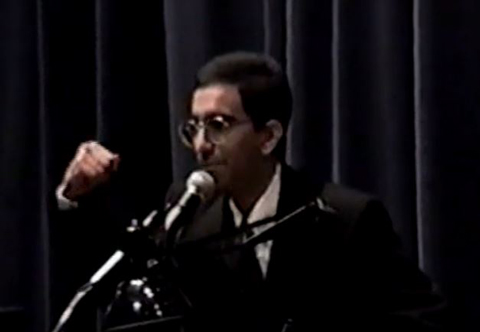
(Right) A teenage Rajiv doing his comedy shtick at an Indian community event in Cincinnati, in 1993.
My parents insisted I had to do something for our cultural programs, so to get away from everyone, I chose the role of MC. People were scared to death to speak in front of 1,000 people but that came very naturally to me. Pawan Singla Uncle in Cincinnati just told my parents he found a video of my doing standup at the age of 17. I actually began at the age of 13. Imagine that—doing impressions and original material in front of a thousand Indians in the community.
Jerry Seinfeld said that standup is a journey into oneself. And much of that journey for me personally has been finding the Indian inside me. I now proudly embrace both sides and am equally comfortable amongst both Indians and Americans. Last year, I actually shared a stage with Seinfeld in New York. And if Seinfeld could’ve seen my going full-on balle-balle Punjabi on the dance floor later that night, he would’ve seen his own quotation personified.
How did you feel about indulging in Indian food
or clothing amidst your American peers during your
school years?
Simply put, I didn’t do it. And it wasn’t so much
out of embarrassment as it was out of a lack of
opportunity. In December 2015, The Atlantic
put out a piece, “Christmas’s War on
America.” I’ve always loved Christmas; I still
get excited about it. We’d even go to church
with our friends, the Abneys, who had us
over every Christmas Eve in Hamilton, Ohio.
There was never any question that we’d
even consider converting from Hinduism—
it was not religious for us but social. In the
1980s and 1990s, it would’ve been incredible
to celebrate Diwali at Fairfield High School.
It wasn’t even in the consideration set or the
Overton Window.
Somebody once said that “Beware of the Boys” by Panjabi MC and Jay Z was the moment that Indians kids could listen to our music with the car windows down. Till then, it was done on the down-low amongst white folks. That was the watershed moment.
Can you share an anecdote or incident from
your life that stands out as amusing or traumatic
regarding your cultural identity?
In third grade, I became funny. I had a funny friend at school. And my funny uncle from Australia visited us. I envied how they made girls laugh. And between the two of them, I discovered my own sense of humor. In class, I developed my alternating impressive answer/sarcastic comment routine, mostly to get the attention of a specific girl. In fact, when I was awarded my certificate for Perfect Attendance from 2nd grade through 12th, this girl named Jane really should’ve been granted half-credit because I showed up every day to try to get her attention.
Things didn’t really pick up until one day in seventh grade, when Q102, the coolest radio station in Cincinnati, came to our school and broadcast from outside the building. This was also “shorts day.” You see, our district in Fairfield, Ohio, had a very strict “no shorts” policy, but this was the one day that we were allowed to wear shorts.
But the temperature on that day was in the 50s. And I had my own very strict policy of needing to be 60 degrees before I wore shorts or T-shirts. I wanted to wear shorts but I needed to wear pants. What better solution than to wear my shorts on top of my pants? Brilliant. I’m not sure why my parents didn’t stop me but off to school I went.
We all got to go outside to listen to Q102 play music and then they asked if anyone wanted to do karaoke. Since I looked decidedly unique, kids shoved me forward and handed me the mic. I was petrified. For years, I’d played viola in the Dorkestra because I didn’t want to be in Chorus. So, there I was with the mic in my hand and one thousand kids egging me on. I mean, this was Q102, the pop station with the DJ we all listened to, and I was about to go down in the annals of Cincinnati audio history. So, I dedicated a song to Jane. I asked for “We Didn’t Start the Fire,” because, of course, this nerd knew all the words. I danced all over the place with that mic in my hand. The place went haywire. I even busted out my MJ moves. And topped it all off by rapping Tone Loc’s “Wild Thing.” And Jane...! Dude...! Jane...was completely unaffected by it.
That incident did put me on the map, though. It boosted my social capital. By high school, my popularity propelled, as I became class president. Jane and I started talking on the phone—because she was white and I was Indian and she’d call me about homework. And then one night she called and I was thinking, “But we don’t have anything due tomorrow.” Is she ... socializing with me? In fact, it was Jane who actually got me into watching standup comedy, since she’d call me on Friday nights and we’d both turn on FOX’s Comic Strip Live and watch it together over the phone.
I’d started seeing her on the weekends … because we both had soccer matches. I played soccer for twelve seasons, spanning ten years of my life—almost the same length of time I was trying to get Jane to like me. And in a decade of playing ball, I never scored a goal. Not once. The funny thing was that I didn’t suck. I had a lot of assists. I could dribble. I could pass. I could run. I could kick. I just couldn’t score. It’s almost like a metaphor.
At the time, I thought the reason Jane didn’t go for me was that I was not good-looking enough. I mean, I had the personality, so what else could it be? Now I can tell you that it had nothing to do with whether I was too skinny or too hairy or too nerdy or too cheap or too honest or too talkative or too crazy or too short. I was too Indian. It was Ohio in the 1980s. Jane wasn’t a racist. I just wasn’t what “hot” meant. And there’s nothing I could’ve done about it. It was worse than being in the friend zone. You can get out of the friend zone. You can’t get out of the Indian zone.
Do you feel the hyphenated identity as an Indian-American has been more of a blessing, or a curse? Or has it changed over your lifetime?
It may have some downsides, sure, but I’d say it’s very much a net positive. In America, there’s family and there’s society. But when you’re part of an immigrant group, especially immigrants of choice and not necessity, you have an additional median layer there—community. And that sense of community provides a structure, guidance, and rubric for success. I love American society, but their concept of family is very different from ours. It’s far more detached. Parents generally cannot wait till their kids are 18 and “out of their hair.” The family bonds we have are generally much stronger. Intimacy and affection are at a whole
’nother level. Not always and in every case, but it’s a
trope that is absolutely rooted in truth.
Has America’s shift to the extreme right in the
recent Trump years cramped your expression as a
brown person in the U.S.?
Absolutely, Donald Trump
has made everything worse. He’s
made comedy worse (because
comedy is about exaggeration
and he’s such a parody of himself
that he leaves comedians
nowhere to go but down) … he’s
destroyed the Republican Party
… and he’s even worsened the
Democrats because the Far Left’s
knee-jerk reactions to him are
horrendous. My heart breaks for
what this country could’ve been.
People read my social media posts and say I’ve gone crazy. But I didn’t go crazy; the country went crazy. I’ve been standing right here. Why am I so mad? Here it is: our President has changed the country and therefore my self-perception. My entire identity has been thrown into question. The story I’ve always told myself is that I’m a guy who grew up in Middle America. I get a lot of people trying to diagnose me and suggest this is where my anxiety stems from. “You grew up as a slice of pumpernickel in a big white breadbasket.” Fair. Pun intended.
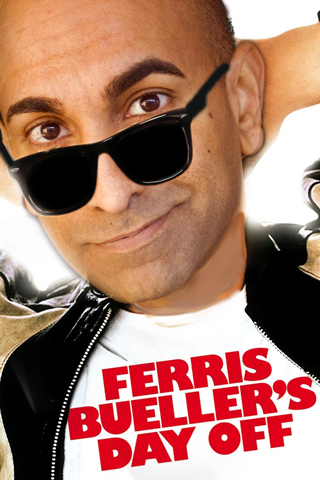
(Left) “In high school, I didn’t think of myself as the Brown Ferris Bueller. I thought of myself as Ferris Bueller,” says Rajiv Satyal.
But know this: I have no bone to pick with the whites—no axe to grind, no score to settle. I very much love “the real Americans” and how welcoming they have been to my family. In high school, I didn’t think of myself as the Brown Ferris Bueller. I thought of myself as Ferris Bueller.
Now, I no longer feel comfortable visiting my own birthplace. I go to Ohio and I’m a Californian. In California, I’m an Ohioan. I go to India, I’m an American. In America, I’m an Indian. I just feel like I have no home.
What did you learn from the responses to your “I
AM INDIAN” video?
Let’s put it this way: I’ve gotten myriad notes from
immigrant parents in America who’ve written to me
with, “I’ve tried to impart Indian values to my kids. But
they mostly resisted. When they saw your video, it was
the first time they embraced being Indian.” I mean,
that brings tears to my eyes. If I get nothing else done
the rest of my career, I’ve made it.
What then motivated you to do the “I AM
AMERICAN” video?
I was asked at a Hindu American
Foundation event in Dallas, Texas, if
I was an Indian first or a Hindu first.
I somehow gave an answer to the
sold-out crowd that got a standing
ovation. As the organizers said, “I
wish we would’ve taped that.” It was
one of those moments where you
feel like an empty vessel and God is
speaking through you, like I blacked
out and can take no credit for it. All
I know is the dichotomy came down
to this: “My body is Indian but my
soul is Hindu, so I’d have to be more
Hindu than Indian.”
Similarly, my ethnicity is Indian but my nationality is American. I wanted to make a video that attempted to bring us together. The challenge I faced was what a friend of mine said: “When you made “I AM INDIAN,” it was original because nobody had ever summed up India in two minutes. The thing about “I AM AMERICAN” is that it is almost by definition American to thump our chests. That’s why I love your video but I don’t think it’ll be met with the same success.” That, and we’re so divided right now that it’s not like only one video can put Humpty Dumpty back together again.
And it also told me that while I play to all humans and all Americans, the base that has supported me and will continue to support me in the future is Indians … South Asians … Hindus … you know, the brown folk.
[Interviewed by Parthiv N. Parekh, editor-in-chief, Khabar magazine.]
Enjoyed reading Khabar magazine? Subscribe to Khabar and get a full digital copy of this Indian-American community magazine.
blog comments powered by Disqus




